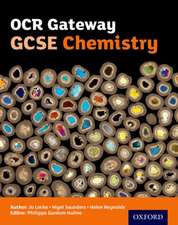Fresh Citrus Fruits
Autor Wilfred F. Wardowskien Limba Engleză Paperback – 15 noi 2012
Preț: 654.77 lei
Preț vechi: 770.31 lei
-15% Nou
Puncte Express: 982
Preț estimativ în valută:
125.29€ • 131.14$ • 104.28£
125.29€ • 131.14$ • 104.28£
Carte tipărită la comandă
Livrare economică 31 martie-14 aprilie
Preluare comenzi: 021 569.72.76
Specificații
ISBN-13: 9781468487947
ISBN-10: 1468487949
Pagini: 592
Ilustrații: XIX, 571 p.
Dimensiuni: 155 x 235 x 31 mm
Greutate: 0.82 kg
Ediția:Softcover reprint of the original 1st ed. 1986
Editura: Springer Us
Colecția Springer
Locul publicării:New York, NY, United States
ISBN-10: 1468487949
Pagini: 592
Ilustrații: XIX, 571 p.
Dimensiuni: 155 x 235 x 31 mm
Greutate: 0.82 kg
Ediția:Softcover reprint of the original 1st ed. 1986
Editura: Springer Us
Colecția Springer
Locul publicării:New York, NY, United States
Public țintă
ResearchDescriere
World production of citrus fruits continues an upward trend. Total world citrus production in 1961 amounted to about 24 MMT (69% oranges, 11 % tangerines, 11% lemons and limes, and 9% grapefruit) and is projected in 1990 at about 71 MMT (69% oranges, 14% tangerines, 10% lemons and limes, and 7% grape fruit). More than 125 countries and territories produce some type of citrus fruit; however, nearly 70% of the world total (54 MMT) in 1983 was accounted for by the ten largest producers, viz., United States (22.2%), Brazil (18.6%), Japan (6.6%), Spain (5.5%), Italy (4.8%), Mexico (4.0%), Argentina (2.8%), Israel (2.6%), Turkey (2.6%), and Egypt (1.8%). In 1983, about 60% of world citrus production was consumed in fresh form. During the 1960s and 1970s, fresh consumption increased at an average rate of about 4% per year; however, projections for the 1980s and 1990s show an annual average rate of only 2%. Countries differ in the utilization of their citrus crop. As an example, Mediterranean Basin countries use 80% of their production in fresh form, whereas the two largest citrus producers, the United States and Brazil, use less than 40% of their production in fresh form. The Mediterranean Basin countries are also the largest exporters of fresh citrus, accounting for about 75% of the world total. The major fresh citrus fruits exported in 1981 were oranges, (58%), tangerines (15%), lemons and limes (15%), and grapefruit (12%).
Cuprins
1 Anatomy and Physiology.- Anatomy and Morphology.- Physiology and Maturation.- References.- 2 Maturity and Grade Standards.- Historical Background.- Measurement of Fruit Characteristics.- Factors Influencing Local Standards.- Markets and Fruit Marketability.- Summary.- References.- 3 Production Practices That Influence Fresh Fruit Quality.- Climate.- Rootstocks.- Pruning.- Spacing of Trees.- Fertilization and Plant Nutrition.- Pests, Diseases, and Other Injuries.- References.- 4 Growth Regulator Improvement of Postharvest Quality.- Navel Orange.- Other Sweet Oranges.- Tangerines.- Grapefruit.- Limes.- Lemons.- Biochemistry and Physiology.- Conclusions.- References.- 5 Fresh Fruit Cultivars.- Sweet Oranges.- Mandarin and Mandarin Hybrids.- Grapefruit.- Lemons.- Pummelos.- Limes.- Kumquats.- Citrons.- Sour Oranges.- Calamondin.- References.- 6 Production Trends around the World.- 1 United States.- Text.- References.- 2 Brazil, Cuba, and Mexico.- Brazil.- Cuba.- Mexico.- References.- 3 Japan.- Varieties and Production Trends.- Problems in the Japanese Citrus Industry.- References.- 4 Spain.- Text.- References.- 5 Israel.- Text.- References.- 6 Southern Africa.- Distribution.- Production.- Area Planted and Future Production Trends.- References.- 7 Australia.- Cultural Practices.- Production and Utilization.- Marketing.- Postharvest Handling and Treatment.- Factory Prices for Citrus Fruits.- Citrus Consumption.- Imports.- Future Outlook.- References.- 8 China.- Producing Regions.- Citrus Cultivars.- Rootstocks.- Propagation Methods.- Orchard Practices.- Diseases, Pests, and Cold Injury.- 7 Harvesting Techniques.- Manual Picking.- Mechanical Picking Aids.- Mechanical Harvesting Methods.- Fruit Collection Methods.- Fruit Quality.- Economic Considerations.- Present Assessment and Future Trends.- References.- 8 Transportation to the Packinghouse.- Some Principles.- Major Transportation Systems.- Florida Bulk-Handling Experience.- References.- 9 Coordination of Fresh Fruit and Processing Outlets.- Economic Considerations.- Harvesting.- Packinghouse Handling.- Conclusion.- References.- 10 Degreening.- The Degreening Atmosphere.- Prior Factors Affecting Degreening.- Degreening Room Designs.- Intermittent Degreening.- References.- 11 Separation and Grading of Freeze-Damaged Fruit.- How Fruit Freezes.- U.S. Grades for Freeze Damage.- Principles of Specific Gravity Separation.- Setting Up an Efficient Separation System.- Electronic Detection Methods.- References.- 12 Packingline Machinery.- Principles.- The Basic Packinghouse Line.- Minimizing Fruit Damage on the Packinghouse Line.- Calculating Packingline Capacity.- References.- 13 Postharvest Citrus Diseases and Their Control.- Development of Postharvest Diseases.- Control of Postharvest Diseases.- Common Fungicides.- Fungicide-Resistant Pathogens.- Experimental Fungicides.- References.- 14 Physiological Disorders.- Preharvest Related Disorders.- Maturity Related Disorders.- Harvesting-Induced Disorders.- Postharvest Related Disorders.- Conclusions.- References.- 15 Washing, Waxing, and Color-Adding.- Washing and Waxing—An Overview.- Washing and Dewatering.- Solvent Wax Application.- Water-Wax Application.- Lemon Storage Wax Process.- Color-Adding.- Removing Sooty Mold.- References.- 16 Packaging and Unitization.- Citrus Containers and Packaging Materials.- Citrus Unitization.- Physical and Environmental Considerations for Shipping-Container Design and Unitization.- References.- 17 Plant Pest Regulations.- History.- Principles.- Natural Barriers to Spread of Pests.- Citrus Fruit Pests.- Arthropods.- Mollusca.- Plant Pathogens.- Certification Procedures for Citrus Fruits.- Summary.- References.- 18 Pesticide Tolerances.- How Pesticide Tolerances Are Established.- Acceptable Daily Intake.- Tolerance in Relation to Citrus.- Established Tolerances for Citrus and Citrus Products.- Codex Alimentarais Commission.- Pesticide Tolerances for Food Additives.- Summary.- References.- 19 Transportation to Markets.- Losses in Transit.- Time in Transit.- Protective Services in Transit.- Preloading Procedures.- Characteristics of Transport Vehicles.- Mixed Loads.- Conclusions.- References.- 20 Storage of Citrus Fruits.- Identifying the Major Hazards.- Preharvest Factors.- Harvesting.- Postharvest Prestorage Treatments.- Storage Conditions.- Criteria for Judging Storage Life.- Poststorage Handling.- Mandarin-Type Varieties.- A Note on Thermodynamics.- References.- 21 World Fresh Citrus Trade—A Long-Term View.- Exports.- Imports.- Import Projections.- References.- 22 Energy in Citrus Packing.- Energy Usage in Producing Citrus for Fresh Market.- Energy Survey for Citrus Packing.- Energy Auditing.- Overall Energy Projections.- References.








